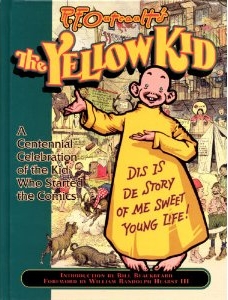|
Tales from the Crypt: The Official Archives Book review by Thomas M. Sipos |
|
MENU Books Horror Film Festivals and Awards
Pursuits
Blogs Horror Film Festivals and Awards
Other
|
Tales from The Crypt: The Official Archives, by Digby Diehl. Designed by David Kaestle & Rick DeMonico (St. Martin's Press; 256 pages; trade paperback; US: $19.95, Canada : $27.99)
A mere comic book in 1950, today Tales from the Crypt and its Crypt Keeper are trademarks whose value exceeds their initial medium, much as Disney's Mickey Mouse surpasses the value of his cartoons. And if Mickey means amiable family entertainment, the Crypt Keeper signifies a particular kind of horror tale: one combining brevity, gore, black humor, and moral irony.
In 1933, Max Gaines conceived of reprinting comic strips into pulp books, making him the Father of the Comic Book. In 1945, his partners at Action Comics bought him out and he founded Educational Comics, publishing titles such as Picture Stories from the Bible and Bouncy Bunny in the Friendly Forest. He died in a 1947 boating accident, saving a child's life while perhaps sacrificing his own. Bill Gaines grew up hating and avoiding comics because they had represented Max, a critical and demanding father. Now Bill's mother insisted that he run EC. He did, changing EC from Educational to Entertaining Comics, and hiring Al Feldstein to draw an Archie clone, Going Steady With Peggy. But Bill soon dropped the idea of cloning successful trends, a standard publishing practice then (and now?), and created what he called his New Trend titles. The history of EC's New Trend horror and crime comics (Tales from the Crypt, Vault of Horror, Haunt of Fear, Crime SuspenStories, Shock SuspenStories) informs much of Diehl's book, but there is much else. We read of Weird Science and Weird Fantasy, Bill's sci-fi comics tolerated out of love since they never achieved the success of their horror siblings; the GhouLunatics (Crypt Keeper, Vault Keeper, Old Witch); Harvey Kurtzman's distaste for horror, his meticulous attention to military detail in his beloved EC war comics (Two-Fisted Tales, Frontline Combat), and his creation of, and defection from, MAD; EC's plagiarism of Ray Bradbury's "What The Dog Dragged In," leading to a long, congenial working relationship with Bradbury (but who later requested that his name not be put on covers, as he worried that being adapted by the comics hurt his authorial reputation); and the cloning of the New Trend, so that by 1953 about 150 competing horror titles were being published, today mostly forgotten.
Sections on each EC artist includes bios and samples of his unique style. Al Feldstein, who wrote and edited most of the New Trend, demanded that each artist have his own signature style. Bill Gaines encouraged it by instituting an "Artist of the Issue" kudos page, a respect rarely accorded by other publishers. EC's five horror and crime titles all folded in 1954, due to public outcry against comic book sex and violence. Psychiatrist Dr. Fredric Wertham of the New York Department of Hospitals and Harlem's Lafargue Clinic led the fight. Powerful enemies against EC included gossip columnist Walter Winchell, waging a vendetta against EC business manager Lyle Stuart (whose book had revealed the "seamier side of Winchell's private life"); Senator Estes Kefauver (D-Tenn) of the Senate Subcommittee to Investigate Juvenile Delinquency and a presidential hopeful; and EC's competitors, particularly Archie Comics's John Goldwater and DC's Jack Liebowitz. As President and Veep of the Comics Magazine Association of America (CMAA), Goldwater and Liebowitz prohibited the words "horror, terror, crime, and weird" for a comic book to earn the CMAA's new seal of approval, required by distributors. EC's strength was its horror and crime titles, unlike its competitors. Ironically, Bill Gaines had called the meeting at which the CMAA was formed. Wertham recruited support from "women's groups and religious organizations," vilifying horror and crime comics for their "detailed descriptions of all kinds of felonies, torture, sadism, attempted rape, flagellation" and portraying women "in a smutty, unwholesome way, with emphasis on half-bare and exaggerated sex characteristics." He decried all horror and crime comics, but EC had the most to lose. Ironically, EC was rare among publishers in diluting its horror with humor. The GhouLunatics' wry commentaries distanced readers from the suffering characters. One rare political hero was New York Governor Thomas Dewey, who vetoed "numerous bills outlawing horror comics." But though attempts at state censorship failed, bad press, public pressure, and boycotts discouraged distributors and retailers from carrying EC. Bill Gaines summarized, "Magazines that do not get onto the newsstand do not sell." Gaines requested permission to testify before Kefauver. In his statement (reprinted by Diehl) Gaines says, "I do not believe that anything that has ever been written can make a child hostile, over-aggressive, or delinquent." Here he was disingenuous, or at least contradictory. Gaines believed in comics' power to influence youth, periodically publishing what he called preachies (tales condemning racism, anti-Semitism, drugs, etc.), usually in Shock SuspenStories. And if art can influence for good, it follows that it can influence for ill. The question should not have been: are violent comics potentially harmful? Tobacco, marijuana, airplanes, cars, guns -- and yes, art and ideas -- are all potentially harmful. To users, to third parties, to children. The proper question is: Do we chose to live and raise children in a society that assumes the risks of liberty, or do we wish a society cocooned, safe, and inoffensive, hypersensitive to the sensibilities of all? Although Diehl makes no connection, Wertham began his campaign in 1948 and Bradbury began Fahrenheit 451 in 1950. One wonders what influence the psychiatrist had on the author. For the society in Fahrenheit 451 is a democracy, one in which whatever book offends any group is banned, until none are left. Unlike 1984's obvious state totalitarian target, Fahrenheit 451 reveals that people can discard their freedom by choice. Yet as EC so often demonstrated in its pages, you can't keep the dead down. The Crypt Keeper lived on. In fanzines, in Russ Cochran's hardcover reprints (published in black & white so as to display the artists' meticulous ink lines), in the Amicus films, in the HBO series (Diehl includes a 93-episode guide covering the first seven seasons), in the more recent films, in the Tales from the Cryptkeeper cartoon. All covered, if only a page. There are a few errors (remarkably, Boris Karloff is referred to as William Henry Platt). Thankfully, there's an index, albeit incomplete. No reference to Karloff under any name. Not covered are the Amicus film novelizations by Jack Oleck. Although pictured in the collectibles section, there's no information on its making. I miss it because it was both my introduction to Tales from the Crypt (being underage for the Amicus film) and my first "adult" book. To boomers, Tales from the Crypt is a comic book. To Xers, an HBO series. To those born in between, the Crypt Keeper is Ralph Richardson, seen on the back of Oleck's novelization. Diehl's book reprints four "classic" stories and all 105 EC horror and crime covers (nine per page). Extensively researched, generously illustrated. If you have a serious interest in Tales from the Crypt, you'll want this book. Review copyright by Thomas M. Sipos
|
"Communist Vampires" and "CommunistVampires.com" trademarks are currently unregistered, but pending registration upon need for protection against improper use. The idea of marketing these terms as a commodity is a protected idea under the Lanham Act. 15 U.S.C. s 1114(1) (1994) (defining a trademark infringement claim when the plaintiff has a registered mark); 15 U.S.C. s 1125(a) (1994) (defining an action for unfair competition in the context of trademark infringement when the plaintiff holds an unregistered mark).


